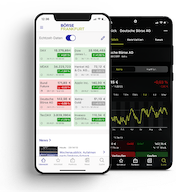Dossier trade
Protection in extreme situations

The volatility interruption is one of the most important protective mechanisms in Xetra trading on the Frankfurt Stock Exchange. It ensures that exchange trading runs smoothly even in extreme market conditions.
March 12, 2020 was a turbulent day on the global financial markets. The Corona crisis and the oil price shock created an extremely volatile mood on the stock markets. Prices plunged by double-digit percentages everywhere. On this day, the stock exchange infrastructure was put under greater strain than at any time since the brexite decision and the financial crisis of 2008. But thanks to established protection mechanisms, stock exchange trading functioned smoothly.
Slowing down trading
The volatility interruption, or “vola” for short, made an important contribution that day. If the price of a security starts to swing too wildly, trading is switched automatically from continuous trading to auction for at least two minutes. This decelerates trading, gives market participants time to get their bearings and prevents the market from taking off unchecked in one direction.
Another important factor is that trading in the affected security is not suspended when a volatility interruption is triggered. Suspension generally results in even greater uncertainty amongst market participants and further increases volatility. In the auction phase, which replaces continuous trading, market participants can continue entering, changing and deleting their orders. But of course during the auction, orders are not automatically executed immediately, but collected until the end of the auction phase. Market participants continue to see an indicative auction price, i.e. the price that would be struck if the auction were to end at that given moment. That way, the consequences of the situation remain calculable for all trading participants.
During a volatility interruption, the system switches from continuous trading to an auction.
Advantages of the volatility interruption at a glance
- It prevents large price swings regardless of the direction the market is moving – swings caused e.g. by incorrect order entry, illiquid market conditions or the entry of unlimited orders with too high transaction volumes.
- This gives market participants an opportunity to adjust their view of the market by looking at the overall situation, taking other markets into account and checking their own order situation.
- It also gives Deutsche Börse’s Market Supervision a chance to assess the situation – for example, the order book, the news situation or the causes of the interruption.
- It gives all participants the opportunity to analyse the situation calmly during an extremely hectic market phase.
- It bundles market liquidity: a price based on orders from many market participants is considerably more robust and indicative than a single price based on only two orders in a fast-moving market.
Individual price corridors act as triggers
So what triggers a volatility interruption? Every security in Xetra trading has two individual price corridors, a static one and a dynamic one. During continuous trading, these corridors always move parallel to the price of the security. The static corridor is based around the opening price in the morning and is relatively wide. The dynamic corridor is narrower and brackets the last price determined. The volatility interruption is triggered if the price lies outside one of these corridors at the next pricing. Trading then switches from continuous trading to an auction with a duration of at least two minutes. The auction ends at a random point in time to avoid price manipulation.
Protective corridor: each security has a static and a dynamic price corridor. If the price leaves one of the two corridors, the volatility interruption is triggered.
What happens when the volatility interruption ends
At the end of the volatility interruption, the auction price is determined and continuous trading can be resumed. If the determined price still lies outside one of the previously defined corridors, an extended volatility interruption sets in. In this case, Deutsche Börse’s Market Supervision takes over and continuously monitors the process. The staff look at the overall situation including the auction process and then manually terminate the auction and thus also the volatility interruption. As soon as Market Supervision comes to the conclusion that the auction order book leads to a robust new price level, the auction price is determined and the auction leads back to continuous trading.
Additional protective mechanisms
There are protective mechanisms such as the volatility interruption along the entire trading process chain. For instance, when an order is entered, the trading system checks it for plausibility in order to, for example, avoid the limit and the volume being mixed up during input. In addition, a variable “curbing mechanism” ensures that the maximum number of orders per second is technically limited, so the entire system is not slowed down by individual participants. Then, in order execution, the independent Trading Surveillance Office, or HüSt for short, makes certain that a fair price is determined for every investor in accordance with exchange rules. And in post-trading, Eurex Clearing, Deutsche Börse’s clearing house, ensures that risks are minimised through real-time management and that the securities are actually delivered and paid for.
November 2020, © Deutsche Börse AG




